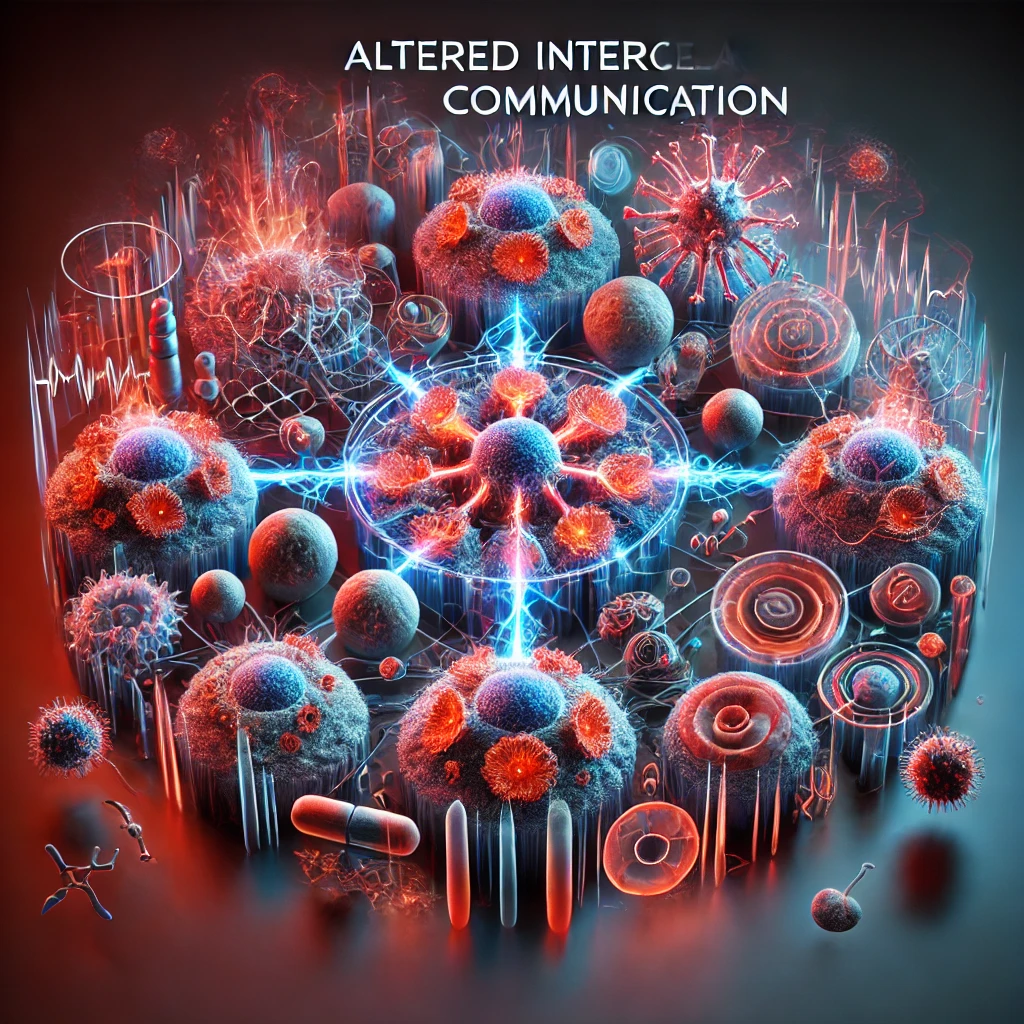Intercellular communication—the complex signaling between cells, tissues, and organs—is essential for maintaining systemic homeostasis. However, with age, these signaling networks become disrupted, leading to chronic inflammation, hormonal imbalances, and immune system dysregulation. This article explores the mechanisms behind altered intercellular communication, its impact on aging, and potential strategies for intervention.
What is Altered Intercellular Communication?
Altered intercellular communication refers to the age-related breakdown of signaling pathways that coordinate biological functions. Key components include:
- Chronic Low-Grade Inflammation (Inflammaging):
- Senescent cells secrete a harmful mix of pro-inflammatory cytokines, chemokines, and proteases, collectively known as the senescence-associated secretory phenotype (SASP).
- Visceral Adiposity: Accumulation of fat in the abdomen contributes to systemic inflammation by releasing inflammatory adipokines.
- Dysregulated Gut Microbiome: An imbalanced microbiome amplifies inflammation through endotoxins and other inflammatory signals.
- Neuroendocrine Changes:
- Altered hormone levels, such as reduced growth hormone, sex hormones, and increased cortisol, disrupt tissue repair and metabolic regulation.
- Immune System Dysregulation:
- Immunosenescence: Age-related decline in immune cell function reduces pathogen clearance and vaccine efficacy.
- Overactive Immune Responses: Malfunctioning immune cells contribute to tissue damage and chronic inflammation.
Consequences of Altered Intercellular Communication
Disruptions in intercellular signaling contribute to:
- Increased risk of chronic diseases, including cardiovascular disease, diabetes, and neurodegenerative disorders.
- Impaired tissue repair and regeneration.
- Loss of systemic homeostasis, exacerbating the aging process.
Potential Interventions
To mitigate the effects of altered intercellular communication, interventions target inflammation, hormonal balance, immune regulation, and overall systemic signaling.
1. Anti-Inflammatory Strategies
- Dietary Components:
- Omega-3 Fatty Acids: Found in fish oil, these compounds reduce systemic inflammation by modulating cytokine production.
- Polyphenols: Natural antioxidants like curcumin (from turmeric) and resveratrol (from grapes) have anti-inflammatory properties.
- Pharmacological Agents:
- Low-Dose Rapamycin: Inhibits mTOR, reducing pro-inflammatory signaling and enhancing autophagy.
- Metformin: An AMPK activator that lowers inflammation and improves metabolic health.
- Gut Microbiome Optimization:
- Prebiotics and Probiotics: Promote a balanced microbiome, reducing endotoxin-driven inflammation.
- High-Fiber Diet: Supports gut health and beneficial microbial populations.
2. Hormonal Modulation
- Hormone Replacement or Optimization:
- Under clinical supervision, correcting severe deficiencies (e.g., thyroid hormone, testosterone, estrogen) can restore some aspects of youthful physiology.
- Lifestyle Interventions:
- Regular exercise, stress management, and proper sleep promote hormonal balance, improving levels of cortisol, melatonin, and other regulatory hormones.
3. Immunomodulation
- Vaccinations and Immune Support:
- Staying up-to-date on vaccinations, particularly for influenza and pneumonia, supports immune resilience.
- Maintaining adequate levels of vitamin D, zinc, and other micronutrients enhances immune function.
- Cell Therapies and Immune Rejuvenation:
- Thymus Regeneration: Emerging therapies aim to rejuvenate the thymus, a key organ for T cell production.
- Adoptive Cell Transfer: Experimental approaches involve enhancing immune surveillance by reintroducing functional immune cells.
4. Anti-SASP Interventions
- SASP Inhibitors:
- Compounds like rapamycin and metformin can suppress the SASP, reducing systemic inflammation and improving intercellular communication.
- Senolytics:
- Agents such as dasatinib and quercetin selectively target and eliminate senescent cells, reducing the SASP’s negative effects on tissues.
Challenges and Future Directions
While these strategies show promise, several challenges remain:
- Target Specificity: Many interventions affect broad pathways, requiring precise targeting to avoid side effects.
- Long-Term Safety: Chronic use of pharmacological agents needs thorough evaluation to mitigate risks.
- Individual Variation: Genetic and environmental factors influence the effectiveness of interventions, necessitating personalized approaches.
Future research will focus on refining these interventions, developing biomarkers to monitor intercellular signaling, and translating experimental therapies into safe clinical applications.
Conclusion
Altered intercellular communication is a fundamental driver of aging, contributing to systemic inflammation, hormonal imbalances, and immune dysfunction. By addressing these disruptions through dietary, pharmacological, and lifestyle interventions, it is possible to improve overall health and delay the onset of age-related diseases. Continued advancements in this field hold the potential to significantly enhance healthspan and quality of life.



